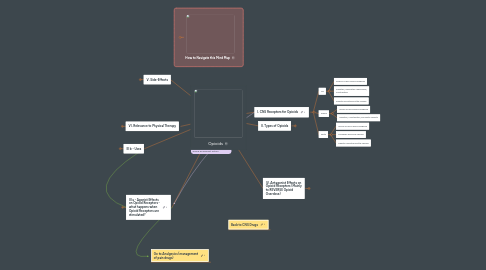
1. I. CNS Receptors for Opioids
1.1. Mu
1.1.1. Spinal & supra-spinal analgesia
1.1.2. Sedation, respiratory depression, constipation
1.1.3. inhibits neurotransmitter release
1.2. Kappa
1.2.1. Spinal & supra-spinal analgesia
1.2.2. Sedation, constipation, psychotic effects
1.3. Delta
1.3.1. Spinal & supra-spinal analgesia
1.3.2. Increases hormonal release
1.3.3. Inhibits neurotransmitter release
2. V. Side-Effects
2.1. Highly Addictive & Dependency-forming
2.2. Social
2.2.1. Crime
2.2.2. Neglect of Work & Family
2.3. CNS
2.3.1. Drowsiness
2.3.2. Falls
2.3.3. Injuries while under influence
2.3.4. Sleep walking & Related Unfortunate Events
2.4. Cardiopulmonary
2.4.1. Hypotension
2.5. Pulmonary Complications
2.5.1. Reduces Medullary Chemoreceptor responsiveness to CO2 & reduces RR (resp rate), reduces PaO2 (Hypoxia), and Increases PaCO2 (Hypercarbia)
2.5.1.1. Respiratory Response to Exercise will be blunted (it will not increase RR in response to exercise)
2.6. Gastrointestinal
2.6.1. Constipation due to Gastrointestinal Effects of slowing Peristalsis
3. VI. Relevance to Physical Therapy
3.1. Strongest Pain Medication - Hence benefits outweigh the troublesome side-effects and promote its usage
3.1.1. Facilitates Movement & Exercise by altering pain "feeling" after Surgery or Major Trauma
3.2. Timing of Therapy - Should be about 60 mins after administration for Pain - Drugs reach Peak Activity in approx. this much time
3.3. Addictive & Habit-forming
3.3.1. Needs strong education to break dependence early during recovery from acute pain
3.4. Upright posture & weight-bearing to help with Gastrointestinal regulation (counteract constipation)
3.5. Deliberate Deep Breathing & Coughing Exercises
3.5.1. Reverses Hypoxia, Hypercarbia induced by Opioid Usage - Consider using Incentive Spirometer with higher frequency
3.6. Fall Precautions (can be from drowsiness or Hypotension from Cardiac Effects, Memory Assist, Avoiding Heavy Machinery Use, Avoid Driving (Someone else should drive to appointments)
4. III a - Agonist Effects on Opioid Receptors - what happens when Opioid Receptors are stimulated?
4.1. Strong Opioid Agonists
4.1.1. Treatment of severe pain
4.1.2. Example Drugs
4.1.2.1. Morphine
4.1.2.2. Fentanyl
4.1.2.3. Hydromoephone
4.1.2.4. Meperidine
4.1.2.5. Methadone
4.2. Mild to Moderate Agonists - Lower affinity/efficiency then strong agonists
4.2.1. Treatment of Mild to Moderate Pain
4.2.2. Treatment of Cough
4.2.3. Treatment of Diarrhea
4.2.4. Treatment of SOB in Advanced Cancer
4.2.5. Example Drugs
4.2.5.1. Codeine
4.2.5.2. Hydrocordone
4.2.5.3. Oxycodone
4.2.5.4. Propoxyphene
4.2.5.5. Loperamide
4.3. Mixed Agonists-Antagonists
4.3.1. Exert agonist/antagonist activity simultaneously - used for opioid dependency treatment
4.3.2. Example Drugs
4.3.2.1. Butorphanol
4.3.2.2. Buprenorphine
5. IV. Antagonist Effects on Opioid Receptors (Mainly to REVERSE Opioid Overdose)
5.1. Block all opioid receptors
5.2. Example Drugs
5.2.1. Naloxone
5.2.1.1. Used to reverse Opioid Overdose
5.2.2. Naltrexone
5.2.2.1. Used to treat Alcohol & Opioid Dependence
5.2.3. Nalmefene
5.2.3.1. Used to reverse Alcohol Abuse
5.2.3.2. Also has been used for treating compulsive gambling
6. II. Types of Opioids
6.1. Endogenous Opioids are Naturally Occurring & Regulate all these systems:
6.1.1. Reward Processing in Brain
6.1.2. Immune system
6.1.3. Cardiovascular responses
6.1.4. Musculoskeletal System
6.1.5. GI function
6.1.6. Example of Naturally Occurring Opioids
6.1.6.1. Endorphins
6.1.6.2. Enkephalins
6.1.6.3. Dynorphins
6.2. Exogenous Opioids are drugs that mimic Endogenous Opioids but effect size is bigger - Hence their roles are similar to Endogenous Opioids
6.2.1. See Example Drugs under Agonist & Antagonist Effects
